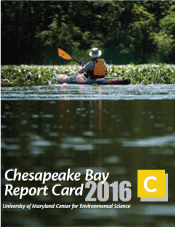Video & Blog Highlights
Videos
- Dr. James Boyd presented the latest Science for Citizens seminar titled "Ecosystem Services Analysis: A Primer". The seminar is divided into two videos each of which are available on IAN's website and YouTube. Part one is on YouTube. Part two is on YouTube.
Blogs
- Turning the report card spotlight back on ourselves: The first Integration and Application Network report card
- Co-development of the Belmont Forum synthesis document
- Evolving ecosystem health report cards to address issues of scale, acceptance, engagement, and behavior change
Chesapeake Bay receives a score of C in 2017
 The Chesapeake Bay received a C grade in the 2016 UMCES Chesapeake Bay Report Card, which was released May 8 along Baltimore's Inner Harbor. This is the 11th UMCES Chesapeake Bay Report Card. The score of 54% showed a slight improvement from 2015. Improvements in overall health are holding steady, while fish populations strongly improved from a 73% in 2015 to a 90% in 2016, an A grade. This year's report card also focused on the partnerships that work to improve the Bay's health.
The Chesapeake Bay received a C grade in the 2016 UMCES Chesapeake Bay Report Card, which was released May 8 along Baltimore's Inner Harbor. This is the 11th UMCES Chesapeake Bay Report Card. The score of 54% showed a slight improvement from 2015. Improvements in overall health are holding steady, while fish populations strongly improved from a 73% in 2015 to a 90% in 2016, an A grade. This year's report card also focused on the partnerships that work to improve the Bay's health.
IAN traveled to Florida for the kickoff workshop for the Everglades Report Card and System Status Report
 The Everglades is a complex, ecologically diverse system divided into four distinct regions: Northern Estuaries, Lake Okeechobee, Greater Everglades, and Southern Coastal Systems. In mid-March, IAN staff Bill Nuttle, Caroline Donovan, Alex Fries, and Emily Nastase led the first of four workshops in Florida to launch the Everglades Report Card and 2019 System Status Report. The workshop was held in West Palm Beach and participants included individuals of the RECOVER team and regional coordinators from the four Everglades regions. Despite differences between regions, the participants are working together to present the status of the whole system, and describe overall health of the Everglades.
The Everglades is a complex, ecologically diverse system divided into four distinct regions: Northern Estuaries, Lake Okeechobee, Greater Everglades, and Southern Coastal Systems. In mid-March, IAN staff Bill Nuttle, Caroline Donovan, Alex Fries, and Emily Nastase led the first of four workshops in Florida to launch the Everglades Report Card and 2019 System Status Report. The workshop was held in West Palm Beach and participants included individuals of the RECOVER team and regional coordinators from the four Everglades regions. Despite differences between regions, the participants are working together to present the status of the whole system, and describe overall health of the Everglades.
IAN creates tidal water quality factsheets for volunteer monitors
 As part of the Chesapeake Monitoring Cooperative project, IAN produced 12 factsheets describing 14 tidal water quality indicators. These indicators are part of the CMC's tidal water quality Quality Assurance Project Plan and Method Manuals. The factsheets are intended for nontraditional and volunteer monitoring groups to include as part of their water quality monitoring programs as education materials for their volunteers. Additionally, IAN produced 20 matrices that illustrate the overlap between volunteer and nontraditional monitoring groups with the Chesapeake Bay Agreement's outcomes and goals. These products are part of the broader goal of the project to integrate volunteer and nontraditional monitoring data into the Chesapeake Bay Program's monitoring networks.
As part of the Chesapeake Monitoring Cooperative project, IAN produced 12 factsheets describing 14 tidal water quality indicators. These indicators are part of the CMC's tidal water quality Quality Assurance Project Plan and Method Manuals. The factsheets are intended for nontraditional and volunteer monitoring groups to include as part of their water quality monitoring programs as education materials for their volunteers. Additionally, IAN produced 20 matrices that illustrate the overlap between volunteer and nontraditional monitoring groups with the Chesapeake Bay Agreement's outcomes and goals. These products are part of the broader goal of the project to integrate volunteer and nontraditional monitoring data into the Chesapeake Bay Program's monitoring networks.
Jane Thomas is heading Down Under
 Jane Thomas was one of the original Science Communicators with the Integration and Application Network, beginning in 2003. Jane will be returning to her native Australia to take up a job at Charles Darwin University in Darwin, Australia. Her legacy at IAN will include a myriad of IAN Press publications, symbols that she created for the IAN symbol library and the images that she posted to the IAN image library. Jane was instrumental in building our Annapolis presence and she mentored dozens of students, interns and Science Communicators. We wish her well in this next life adventure and will miss her presence in our team.
Jane Thomas was one of the original Science Communicators with the Integration and Application Network, beginning in 2003. Jane will be returning to her native Australia to take up a job at Charles Darwin University in Darwin, Australia. Her legacy at IAN will include a myriad of IAN Press publications, symbols that she created for the IAN symbol library and the images that she posted to the IAN image library. Jane was instrumental in building our Annapolis presence and she mentored dozens of students, interns and Science Communicators. We wish her well in this next life adventure and will miss her presence in our team.

